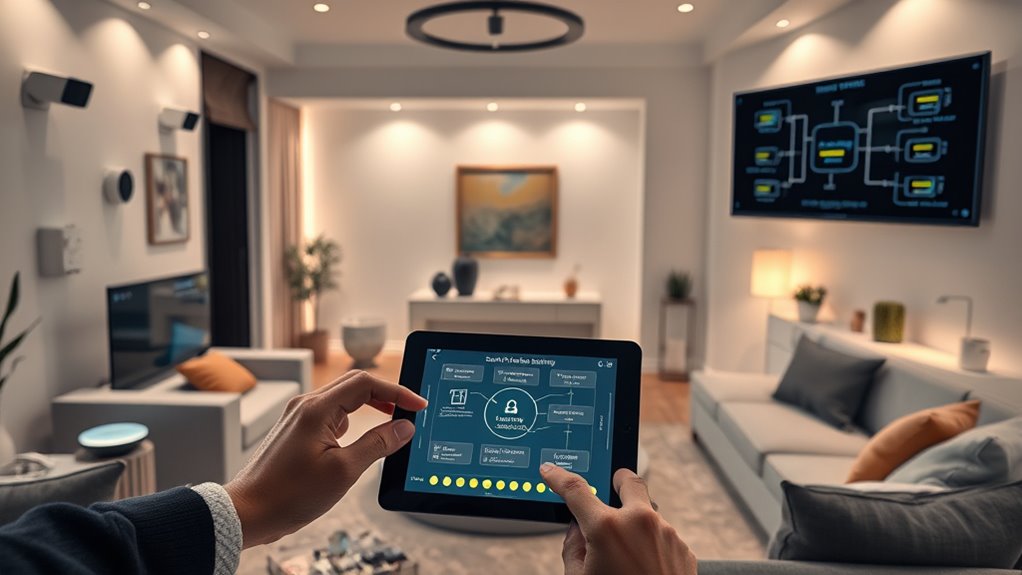To effectively implement zero-trust networking in your home IoT setup, start by segmenting your network into isolated zones for smart devices, PCs, and guest access. Use strong device authentication methods like digital certificates or biometrics and guarantee devices regularly update their firmware. Continuously monitor activity and enforce strict access permissions based on device roles. Adopting these best practices creates a resilient, secure environment—if you want to explore more ways to strengthen your home network, keep going.
Key Takeaways
- Segment your home network into isolated zones for smart devices, PCs, and guest Wi-Fi to limit threat spread.
- Use strong device authentication methods like digital certificates or biometrics during onboarding.
- Implement continuous monitoring and verification for all connected devices and users.
- Enforce strict access controls based on device trust levels and roles to prevent unauthorized access.
- Regularly update device firmware and security credentials to patch vulnerabilities and maintain security posture.

As more smart devices connect to your home network, traditional security measures often fall short in protecting your data and privacy. You need a smarter approach—one that minimizes risks and controls access effectively. Zero-trust networking offers that solution. It operates on the principle of never trusting anything by default, even if it’s inside your network perimeter. Instead, it requires continuous verification for every device and user trying to access resources. To implement this successfully, focus on network segmentation and device authentication. Network segmentation involves dividing your home network into smaller, isolated segments, so if a device is compromised, the threat doesn’t spread across the entire network. For example, you can create separate segments for your smart home devices, personal computers, and guest Wi-Fi. This way, even if a hacker gains access through a vulnerable smart device, they won’t automatically access your personal data or other vital devices. Segmenting your network acts as a barrier, limiting the potential damage and making it easier to monitor suspicious activity within each segment. Ensuring that your projectors and other connected devices support high refresh rates and low input lag can also help maintain optimal performance and security. Device authentication is equally essential. It ensures that only authorized devices can connect to your network and access specific resources. You shouldn’t just rely on passwords or default settings but implement stronger authentication methods, such as digital certificates or biometric verification where possible. This way, each device must prove its identity before gaining access. When a new device attempts to join your network, you should verify its authenticity through a secure onboarding process, ensuring it’s not an imposter. Regularly updating device firmware and security credentials also keeps your network resilient against new vulnerabilities. Combining device authentication with network segmentation creates a layered defense, reducing the chances of unauthorized access and lateral movement within your network. Practicing zero-trust principles means adopting a proactive stance—constantly verifying and monitoring device behavior. You can set up alerts for unusual activity and restrict device permissions based on their role or trust level. For instance, a smart security camera might have different access rights than a smart thermostat. The goal is to enforce strict access controls, so even trusted devices are not given unlimited privileges. Using automated security tools, you can manage and enforce these policies without constantly overseeing every connection manually. This layered approach makes your home network more resilient, adaptable to new threats, and better aligned with zero-trust principles. In the end, by segmenting your network and ensuring robust device authentication, you lay a strong foundation for a secure, private smart home environment that can withstand evolving cyber threats.
Frequently Asked Questions
How Does Zero-Trust Differ From Traditional Iot Security Models?
Zero-trust differs from traditional IoT security by emphasizing strict network segmentation and user authentication. Instead of trusting devices by default, you verify every device and user before granting access. This approach minimizes risks, even if a device is compromised. Unlike traditional models that rely on perimeter defenses, zero-trust continuously monitors and authenticates, ensuring your home IoT environment stays secure and resilient against threats.
What Are the Common Challenges in Implementing Zero-Trust at Home?
Imagine you’re trying to run a spaceship without a proper manual. Common challenges in implementing zero-trust at home include managing user authentication and maintaining network segmentation. You might struggle to verify devices’ identities or keep IoT gadgets isolated, increasing security risks. Balancing convenience with strict controls can be tricky, especially if your network isn’t designed for zero-trust principles. Proper planning helps you overcome these hurdles and secure your smart home.
Can Zero-Trust Networking Improve Device Lifespan and Performance?
Yes, zero-trust networking can improve your device lifespan and performance. By enforcing strict access controls, you reduce risks of malware and unauthorized access that can damage firmware or disrupt operations. Implementing network segmentation isolates IoT devices, preventing compromised devices from affecting others. Regularly updating device firmware and applying zero-trust principles guarantee your network stays secure, enhancing device reliability and longevity.
Is Zero-Trust Suitable for All Types of Iot Devices?
Zero-trust isn’t a one-size-fits-all suit; it can be a tight fit or too bulky depending on your device diversity. Some IoT devices, like simple sensors, might struggle with stringent security measures, while others thrive. Network segmentation helps by creating smaller, secure islands for different devices. So, assess your device types carefully, then tailor your zero-trust approach to keep your entire smart home safe and smoothly running.
How Often Should Home Networks Be Reassessed for Security?
You should reassess your home network’s security at least every three to six months. Regular network monitoring helps you spot unusual activity early, while timely firmware updates ensure your IoT devices stay protected against vulnerabilities. Keep an eye on device behaviors and update settings as needed. Staying proactive with these practices minimizes risks, strengthens your zero-trust approach, and keeps your home environment safe from cyber threats.
Conclusion
By adopting zero-trust networking for your home IoT, you’re turning your smart home into an impenetrable fortress—more secure than Fort Knox! With every device protected behind a digital shield, hackers won’t stand a chance, and your privacy will be safer than ever imagined. It’s like installing an invisible force field around your entire home, making cyber threats vanish into thin air. Embrace these best practices and transform your smart home into an unstoppable, fortress-like sanctuary.








